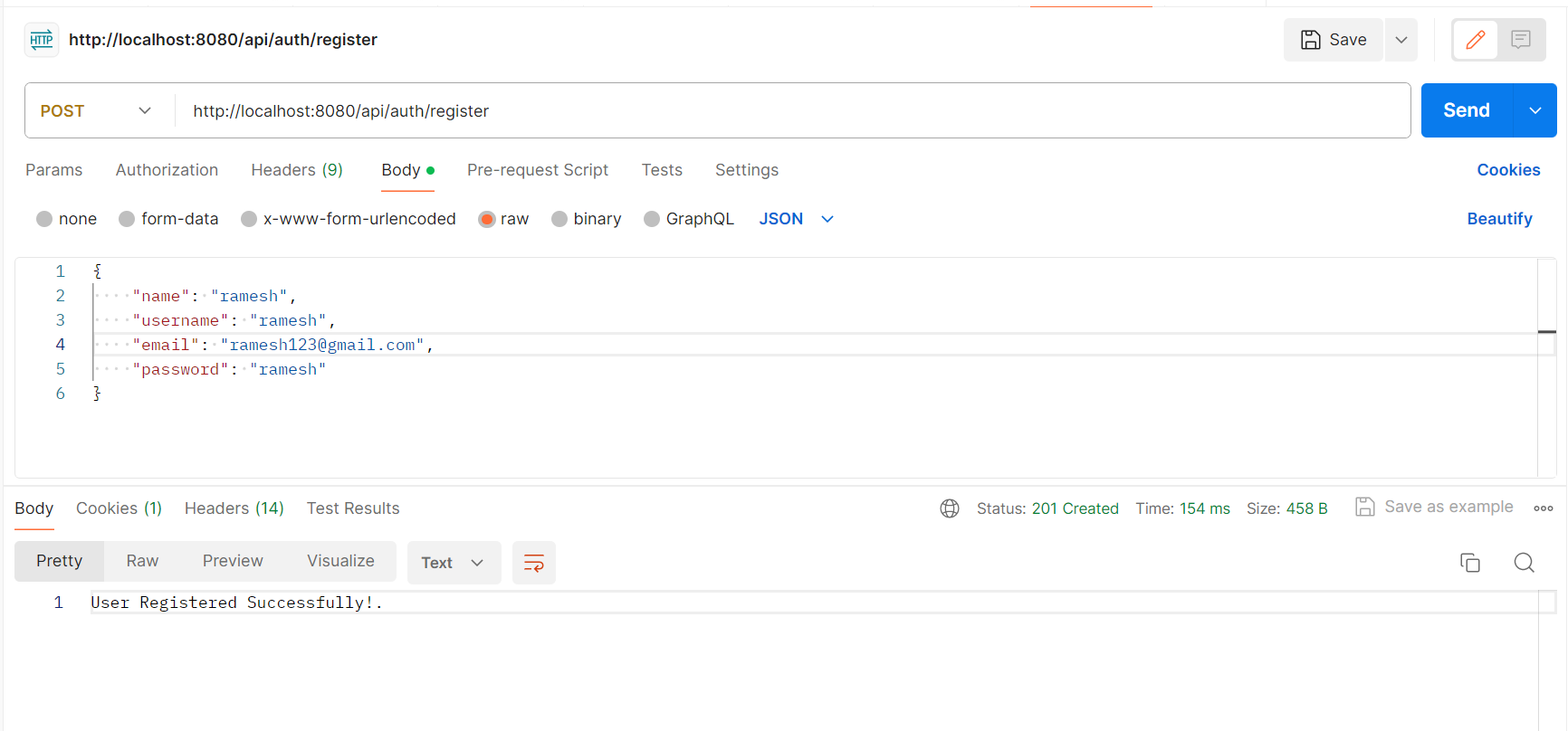In this tutorial, we will build Login and Registration REST API using Spring Boot 3, Spring Security, and MySQL database.
We will create a Registration REST API that will save a registered User in the MySQL database.
Next, we will create a Login REST API so that registered users can log-in using Login REST API.
Spring Security is a framework that provides authentication, authorization, and protection against common attacks. With first-class support for securing both web and reactive applications, it is the de-facto standard for securing Spring-based applications.
1. Add Maven Dependencies
<dependency>
<groupId>org.springframework.boot</groupId>
<artifactId>spring-boot-starter-data-jpa</artifactId>
</dependency>
<dependency>
<groupId>org.springframework.boot</groupId>
<artifactId>spring-boot-starter-web</artifactId>
</dependency>
<dependency>
<groupId>com.mysql</groupId>
<artifactId>mysql-connector-j</artifactId>
<scope>runtime</scope>
</dependency>
<dependency>
<groupId>org.projectlombok</groupId>
<artifactId>lombok</artifactId>
<optional>true</optional>
</dependency>
<dependency>
<groupId>org.springframework.boot</groupId>
<artifactId>spring-boot-starter-test</artifactId>
<scope>test</scope>
</dependency>
<dependency>
<groupId>org.springframework.boot</groupId>
<artifactId>spring-boot-starter-security</artifactId>
</dependency>
2. Configure MySQL Database
Let's first create a database in MySQL server using the below command:
create database login_system
Since we’re using MySQL as our database, we need to configure the database URL, username, and password so that Spring can establish a connection with the database on startup. Open the src/main/resources/application.properties file and add the following properties to it:
spring.datasource.url=jdbc:mysql://localhost:3306/login_system
spring.datasource.username=root
spring.datasource.password=Mysql@123
spring.jpa.properties.hibernate.dialect=org.hibernate.dialect.MySQLDialect
spring.jpa.hibernate.ddl-auto=update
3. Create JPA Entities - User and Role (Many-to-Many Mapping)
User
import jakarta.persistence.*;
import lombok.AllArgsConstructor;
import lombok.Getter;
import lombok.NoArgsConstructor;
import lombok.Setter;
import java.util.Set;
@Setter
@Getter
@NoArgsConstructor
@AllArgsConstructor
@Entity
@Table(name = "users")
public class User {
@Id
@GeneratedValue(strategy = GenerationType.IDENTITY)
private Long id;
private String name;
@Column(nullable = false, unique = true)
private String username;
@Column(nullable = false, unique = true)
private String email;
@Column(nullable = false)
private String password;
@ManyToMany(fetch = FetchType.EAGER, cascade = CascadeType.ALL)
@JoinTable(name = "users_roles",
joinColumns = @JoinColumn(name = "user_id", referencedColumnName = "id"),
inverseJoinColumns = @JoinColumn(name = "role_id", referencedColumnName = "id")
)
private Set<Role> roles;
}
Role
import jakarta.persistence.*;
import lombok.AllArgsConstructor;
import lombok.Getter;
import lombok.NoArgsConstructor;
import lombok.Setter;
@Getter
@Setter
@NoArgsConstructor
@AllArgsConstructor
@Entity
@Table(name = "roles")
public class Role {
@Id
@GeneratedValue(strategy = GenerationType.IDENTITY)
private Long id;
private String name;
}
4. Create Spring Data JPA Repositories
public interface UserRepository extends JpaRepository<User, Long> {
}
public interface RoleRepository extends JpaRepository<Role, Long> {
Role findByName(String name);
}5. Spring Security Implementation
CustomUserDetailsService
import lombok.AllArgsConstructor;
import net.javaguides.todo.entity.User;
import net.javaguides.todo.repository.UserRepository;
import org.springframework.security.core.GrantedAuthority;
import org.springframework.security.core.authority.SimpleGrantedAuthority;
import org.springframework.security.core.userdetails.UserDetails;
import org.springframework.security.core.userdetails.UserDetailsService;
import org.springframework.security.core.userdetails.UsernameNotFoundException;
import org.springframework.stereotype.Service;
import java.util.Set;
import java.util.stream.Collectors;
@Service
@AllArgsConstructor
public class CustomUserDetailsService implements UserDetailsService {
private UserRepository userRepository;
@Override
public UserDetails loadUserByUsername(String usernameOrEmail) throws UsernameNotFoundException {
User user = userRepository.findByUsernameOrEmail(usernameOrEmail, usernameOrEmail)
.orElseThrow(() -> new UsernameNotFoundException("User not exists by Username or Email"));
Set<GrantedAuthority> authorities = user.getRoles().stream()
.map((role) -> new SimpleGrantedAuthority(role.getName()))
.collect(Collectors.toSet());
return new org.springframework.security.core.userdetails.User(
usernameOrEmail,
user.getPassword(),
authorities
);
}
}
SpringSecurityConfig
@Configuration
@EnableMethodSecurity
@AllArgsConstructor
public class SpringSecurityConfig {
private UserDetailsService userDetailsService;
@Bean
public static PasswordEncoder passwordEncoder(){
return new BCryptPasswordEncoder();
}
@Bean
SecurityFilterChain securityFilterChain(HttpSecurity http) throws Exception {
http.csrf(csrf -> csrf.disable())
.authorizeHttpRequests((authorize) -> {
authorize.requestMatchers("/api/auth/**").permitAll();
authorize.anyRequest().authenticated();
}).httpBasic(Customizer.withDefaults());
return http.build();
}
@Bean
public AuthenticationManager authenticationManager(AuthenticationConfiguration configuration) throws Exception {
return configuration.getAuthenticationManager();
}
}
6. Creating DTO class - LoginDto and RegisterDto
LoginDto
import lombok.AllArgsConstructor;
import lombok.Getter;
import lombok.NoArgsConstructor;
import lombok.Setter;
@Getter
@Setter
@NoArgsConstructor
@AllArgsConstructor
public class LoginDto {
private String usernameOrEmail;
private String password;
}
import lombok.AllArgsConstructor;
import lombok.Getter;
import lombok.NoArgsConstructor;
import lombok.Setter;
RegisterDto
@Getter
@Setter
@NoArgsConstructor
@AllArgsConstructor
public class RegisterDto {
private String name;
private String username;
private String email;
private String password;
}
7. Creating a Service Layer
AuthService
public interface AuthService {
String register(RegisterDto registerDto);
String login(LoginDto loginDto);
}
AuthServiceImpl
@Service
@AllArgsConstructor
public class AuthServiceImpl implements AuthService {
private UserRepository userRepository;
private RoleRepository roleRepository;
private PasswordEncoder passwordEncoder;
private AuthenticationManager authenticationManager;
@Override
public String register(RegisterDto registerDto) {
// check username is already exists in database
if(userRepository.existsByUsername(registerDto.getUsername())){
throw new TodoAPIException(HttpStatus.BAD_REQUEST, "Username already exists!");
}
// check email is already exists in database
if(userRepository.existsByEmail(registerDto.getEmail())){
throw new TodoAPIException(HttpStatus.BAD_REQUEST, "Email is already exists!.");
}
User user = new User();
user.setName(registerDto.getName());
user.setUsername(registerDto.getUsername());
user.setEmail(registerDto.getEmail());
user.setPassword(passwordEncoder.encode(registerDto.getPassword()));
Set<Role> roles = new HashSet<>();
Role userRole = roleRepository.findByName("ROLE_USER");
roles.add(userRole);
user.setRoles(roles);
userRepository.save(user);
return "User Registered Successfully!.";
}
@Override
public String login(LoginDto loginDto) {
Authentication authentication = authenticationManager.authenticate(new UsernamePasswordAuthenticationToken(
loginDto.getUsernameOrEmail(),
loginDto.getPassword()
));
SecurityContextHolder.getContext().setAuthentication(authentication);
return "Login Successful";
}
}
8. Controller Layer - Login and Registration REST API
@AllArgsConstructor
@RestController
@RequestMapping("/api/auth")
public class AuthController {
private AuthService authService;
// Build Register REST API
@PostMapping("/register")
public ResponseEntity<String> register(@RequestBody RegisterDto registerDto){
String response = authService.register(registerDto);
return new ResponseEntity<>(response, HttpStatus.CREATED);
}
// Build Login REST API
@PostMapping("/login")
public ResponseEntity<String> login(@RequestBody LoginDto loginDto){
String token = authService.login(loginDto);
return new ResponseEntity<>(token, HttpStatus.OK);
}
}
9. Insert SQL Scripts
Before testing Spring security, make sure that you use below SQL scripts below to insert the database into respective tables:
INSERT INTO `users` VALUES
(1,'ramesh@gmail.com','ramesh','$2a$10$5PiyN0MsG0y886d8xWXtwuLXK0Y7zZwcN5xm82b4oDSVr7yF0O6em','ramesh'),
(2,'admin@gmail.com','admin','$2a$10$gqHrslMttQWSsDSVRTK1OehkkBiXsJ/a4z2OURU./dizwOQu5Lovu','admin');
INSERT INTO `roles` VALUES (1,'ROLE_ADMIN'),(2,'ROLE_USER');
INSERT INTO `users_roles` VALUES (2,1),(1,2);



Comments
Post a Comment